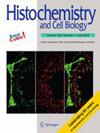大鼠肠道发育过程中的体生长抑素免疫反应神经元
摘要
体生长抑素(SST)是一种表达于外周和中枢神经系统以及内分泌和免疫细胞的多肽。本研究旨在确定 SST 免疫反应性(IR)神经元的百分比及其与胆碱乙酰转移酶(ChAT)、神经元一氧化氮合酶(nNOS)、神经肽 Y(NPY)和神经胶质纤维酸性蛋白(GFAP)的共定位、采用免疫组织化学方法研究了从新生儿到衰老期不同年龄组大鼠小肠(SI)和大肠(LI)肌层神经丛(MP)和粘膜下神经丛(SP)中神经元一氧化氮合酶(nNOS)、神经肽 Y(NPY)和神经胶质纤维酸性蛋白(GFAP)的共定位情况。在 SI 和 LI 的 MP 中,SST-IR 神经元的比例在出生后早期发育过程中显著增加,从新生大鼠的 12 ± 2.4(SI)和 13 ± 3.0(LI)增加到 20 日龄大鼠的 23 ± 1.5(SI)和 18 ± 1.6(LI),并在 60 日龄前保持稳定。随后,2 岁大鼠的 SST-IR 细胞比例降至 14 ± 2.0(SI)和 10 ± 2.6(LI)。在SP中,SST-IR神经元的比例从新生大鼠的22 ± 3.2(SI)和23 ± 1.7(LI)显著上升到20日龄大鼠的42 ± 4.0(SI)和30日龄大鼠的32 ± 4.9(LI),然后在2岁大鼠中下降到21 ± 2.6(SI)和28 ± 7.4(LI)。在出生到 60 日龄期间,MP 和 SP 中 97-98% 的 SST-IR 神经元与 SI 和 LI 神经丛中的 ChAT 共定位。老龄大鼠的 SST/ChAT 神经元百分比在 MP 中下降到 85 ± 5.0(SI)和 90 ± 3.8(LI),在 SP 中下降到 89 ± 3.2(SI)和 89 ± 1.6(LI)。相反,在幼鼠中,只有少数 SST-IR 神经元与 nNOS 共定位,但这一比例在 2 岁大鼠中显著增加。在整个出生后发育过程中,SST/NPY-IR 神经元的百分比表现出相当大的差异,在两个肠道的 MP 和 SP 中,不同年龄组之间没有显著差异。在所有研究动物中均未观察到 SST 与 GFAP 共定位。总之,SST 在肠道神经元中的表达在幼鼠中增加,在衰老期减少,同时 SST 与 ChAT 和 nNOS 的共定位也发生了变化。

Somatostatin (SST) is a peptide expressed in the peripheral and central nervous systems, as well as in endocrine and immune cells. The aim of the current study is to determine the percentage of SST immunoreactive (IR) neurons and their colocalization with choline acetyltransferase (ChAT), neuronal nitric oxide synthase (nNOS), neuropeptide Y (NPY), and glial fibrillary acidic protein (GFAP) in the myenteric plexus (MP) and submucous plexus (SP) of the small intestine (SI) and large intestine (LI) of rats across different age groups from newborn to senescence using immunohistochemistry. In the MP of the SI and LI, the percentage of SST-IR neurons significantly increased during early postnatal development from 12 ± 2.4 (SI) and 13 ± 3.0 (LI) in newborn rats to 23 ± 1.5 (SI) and 18 ± 1.6 (LI) in 20-day-old animals, remaining stable until 60 days of age. The proportion of SST-IR cells then decreased in aged 2-year-old animals to 14 ± 2.0 (SI) and 10 ± 2.6 (LI). In the SP, the percentage of SST-IR neurons significantly rose from 22 ± 3.2 (SI) and 23 ± 1.7 (LI) in newborn rats to 42 ± 4.0 in 20-day-old animals (SI) and 32 ± 4.9 in 30-day-old animals (LI), before declining in aged 2-year-old animals to 21 ± 2.6 (SI) and 28 ± 7.4 (LI). Between birth and 60 days of age, 97-98% of SST-IR neurons in the MP and SP colocalized with ChAT in both plexuses of the SI and LI. The percentage of SST/ChAT neurons decreased in old rats to 85 ± 5.0 (SI) and 90 ± 3.8 (LI) in the MP and 89 ± 3.2 (SI) and 89 ± 1.6 (LI) in the SP. Conversely, in young rats, only a few SST-IR neurons colocalized with nNOS, but this percentage significantly increased in 2-year-old rats. The percentage of SST/NPY-IR neurons exhibited considerable variation throughout postnatal development, with no significant differences across different age groups in both the MP and SP of both intestines. No colocalization of SST with GFAP was observed in any of the studied animals. In conclusion, the expression of SST in enteric neurons increases in young rats and decreases in senescence, accompanied by changes in SST colocalization with ChAT and nNOS.

 求助内容:
求助内容: 应助结果提醒方式:
应助结果提醒方式:


